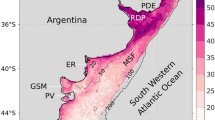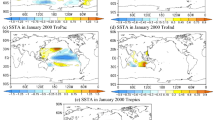Abstract
Several 19-year integrations of the Hamburg version of the ECMWF/T21 general circulation model driven by the monthly mean sea surface temperature (SST) observed in 1970–1988 were examined to study extratropical response of the atmospheric circulation to SST anomalies in the Northern Hemisphere in winter. In the first 19-years run SST anomalies were prescribed globally (GAGO run), and in two others SST monthly variability was limited to extratropical regions (MOGA run) and to tropics (TOGA run), respectively. A canonical correlation analysis (CCA), which select from two time-dependent fields optimally correlated pairs of patterns, was applied to monthly anomalies of SST in the North Alantic and Pacific Oceans and monthly anomalies of sea level pressure and 500 hPa geopotential height in the Northern Hemisphere. In the GAGO run the best correlated atmospheric pattern is global and is characterized by north-south dipole structures of the same polarity in the North Atlantic and the North Pacific sectors. In the MOGA and TOGA experiments the atmospehric response is more local than in the GAGO run with main centers in the North Atlantic and North Pacific, respectively. The extratropical response in the GAGO run is not equal to the sum of the responses in the MOGA and TOGA runs. The artificial meridional SST gradients at 25°–30°N probably influence the results of the MOGA and TOGA runs. The atmopsheric modes found by the CCA were compared with the normal modes of the barotropic vorticity equation linearized about the 500 hPa. winter climate. The normal modes with smallest eigenvalues are similar to the model leading variability modes and canonical patterns of 500 hPa geopotential height. The corresponding eigenvectors of the adjoint operator, which represent an external forcing optimal for exciting normal modes, have a longitudinal structure with maxima in regions characterized by enhanced high frequency baroclinic activity over both oceans.
Similar content being viewed by others
References
Barnett TP, Preisendorfer R (1987) Origins and levels of monthly and seasonal forecast skill for United States surface air temperatures determined by canonical correlation analysis. Mon Weather Rev 115:1825–1850
Barnett TP, Heinz H-D, Hasselmann K (1984) Statistical prediction of seasonal air temperatures over Eurasia. Tellus 36A: 132–146
Barnett TP, Latif M, Kirk E, Roeckner E (1991) On ENSO Physics. J Atmos Sci 4:487–515
Branstator G (1985a) Analysis of general circulation model sea surface temperature anomaly simulations using a linear model. Part I: forced solutions. J Atmos Sci 42:2225–2241
Branstator G (1985b) Analysis of general circulation model sea surface temperature anomaly simulations using a linear model. Part II: eigenanalysis. J Atmos Sci 42:2242–2254
Dymnikov VP, Filin SK (1985a) A correlation study of extratropical sea surface temperature anomalies and heating anomalies based on data from the First CARP Global Experiment. Reprint of the Department of Numerical Mathematics of the USSR Academy of Sciences 83, Moscow, USSR (in Russian)
Dymnikov VP, Filin SK (1985b) Numerical simulation of the atmospheric response to sea surface temperature anomalies in the North Atlantic. Reprint of Department of Numerical Mathematics of the USSR Academy of Sciences 84, Moscow, USSR (in Russian)
Glynn W, Muirhead R (1978) Influence in canonical correlation analysis. J Multivar Anal 8:468–478
Graham NE, Barnett TP, Wilde R, Ponater M, Schubert S (1994) On the roles of tropical and mid-latitude SSTs in forcing interannual to interdecadal variability in the winter Northern Hemisphere circulation. J Clim 7:1416–1441
Hoskins BJ, Karoly DJ (1981) The steady linear response of a spherical atmosphere to thermal and orographic forcing. J Atmos Sci 3:1179–1196
Kharin VV (1995) The atmospheric response to North Atlantic sea surface temperature anomalies in GCM experiments. Max-Planck-Institut für Meteorologie, Hamburg, Examensarbeit 28
Kushnir Y, Lau N-C (1992) The general circulation model response to a North Pacific SST anomaly: dependence on time scale and pattern polarity. J Clim 5:271–283
Lau N-C (1988) Variability of the observed midlatitude storm tracks in relation to low-frequency changes in the circulation pattern. J Atmos Sci 45:2718–2743
Lau N-C, Nath MJ (1990) A general circulation model study of the atmospheric response to extratropical SST anomalies observed in 1950–79. J Clim 3:965–989
Lau N-C, Nath MJ (1994) A modeling study of the relative roles of tropical and extratropical SST anomalies in the variability of the global atmosphere-ocean system. J Clim 7:1184–1207
Metz W (1989) Low-frequency anomalies of the atmospheric flow and the effects of cyclone-scale eddies: a canonical correlation analysis. J Atmos Sci 46:1026–1041
Namias J (1964) Seasonal persistence and recurrence of European blocking during 1958–1960. Tellus 16:394–407
Namias J (1978) Multiple causes of the North American abnormal winter 1976–1977. Mon Weather Rev 106:279–295
Palmer TN, Sun Z (1985) A modelling and observational study of the relationship between see surface temperature in northwest Atlantic and the atmospheric general circulation. Q J R Meteorol Soc 111:947–975
Pitcher EJ, Blackmon ML, Bates GT, Mu S (1988) The effect of North Pacific sea surface temperature anomalies on the January climate of a general circulation model. J Atmos Sci 45:173–188
Ponater M, König W (1991) Interannual circulation regime fluctuations and their effect on intraseasonal variability. In: Sausen R (ed) Meteorologisches Institut Universität Hamburg Large Scale Atmospheric Modelling, Rep 9
Ratcliffe RAS, Murray R (1970) New lag associations between North Atlantic sea temperature and European pressure applied to long-range weather forecasting. Q J R Meteorol Soc 96:226–246
Roeckner F, Arpe K, Bengtsson L, Brinkop S, Dümenil L, Esch M, Kirk E, Lunkeit F, Ponater M, Rockel B, Sausen S, Schlese U, Schubert S, Windelband M (1992) Simulation of the present-day climate with the ECHAM model: impact of model physics and resolution. Max-Planck-Institut für Meteorologie, Hamburg, Rep 93
Ting M (1991) The stationary wave response to a midlatitude SST anomaly in an idealized GCM. J Atmos Sci 48:1249–1275
Wallace JM, Gutzler DS (1981) Teleconnections in the geopotential height field during the Northern Hemisphere winter. Mon Weather Rev 106:296–310
Wallace JM, Jiang Q (1987) On the observed structure of the interannual variability of the atmosphere/ocean climate system. In: Cattle H (ed) Atmospheric and ocean variability, Roy Meteor Soc, 17–43
Wallace JM, Smith C, Jiang Q (1990) Spatial patterns of atmosphere/ocean interaction in the Northern winter. J Clim 118:990–998
Wallace JM, Smith C, Bretherton CS (1992) Singular value decomposition of wintertime sea surface temperature and 500 hPa height anomalies. J Clim 5:561–576
Webster PJ (1981) Mechanisms determining the atmospheric response to sea surface temperature anomalies. J Atmos Sci 38:554–571
Zorita E, Kharin VV, von Storch H (1992) The atmospheric circulation and sea suface temperature in the North Atlantic area in winter: their interaction and relevance for Iberian precipitation. J Clim 5:1097–1108
Author information
Authors and Affiliations
Rights and permissions
About this article
Cite this article
Kharin, V.V. The relationship between sea surface temperature anomalies and atmospheric circulation in GCM experiments. Climate Dynamics 11, 359–375 (1995). https://doi.org/10.1007/BF00215737
Received:
Accepted:
Issue Date:
DOI: https://doi.org/10.1007/BF00215737




